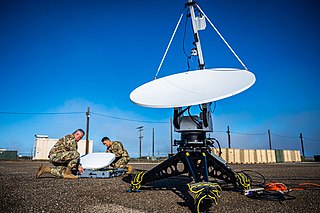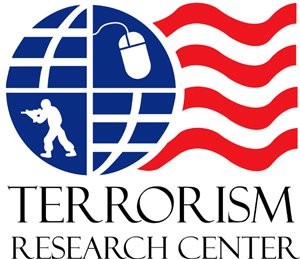Related Research Articles

Electromagnetic warfare or electronic warfare (EW) is warfare involving the use of the electromagnetic spectrum or directed energy to control the spectrum, attack an enemy, or impede enemy operations. The purpose of electromagnetic warfare is to deny the opponent the advantage of—and ensure friendly unimpeded access to—the EM spectrum. Electromagnetic warfare can be applied from air, sea, land, or space by crewed and uncrewed systems, and can target communication, radar, or other military and civilian assets.
A revolution in military affairs (RMA) is a hypothesis in military theory about the future of warfare, often connected to technological and organizational recommendations for military reform.

Maneuver warfare, or manoeuvre warfare, is a military strategy which emphasizes movement, initiative and surprise to achieve a position of advantage. Maneuver seeks to inflict losses indirectly by envelopment, encirclement and disruption, while minimizing the need to engage in frontal combat. In contrast to attrition warfare where strength tends to be applied against strength, maneuver warfare attempts to apply strength against weakness in order to accomplish the mission.

In the field of military theory, the operational level of war represents the level of command that connects the details of tactics with the goals of strategy.

Modern warfare is warfare that diverges notably from previous military concepts, methods, and technology, emphasizing how combatants must modernize to preserve their battle worthiness. As such, it is an evolving subject, seen differently in different times and places. In its narrowest sense, it is merely a synonym for contemporary warfare.

The Terrorism Research Center (TRC) is a non-profit think tank focused on investigating and researching global terrorism issues through multi-disciplinary collaboration amongst a group of international experts.

The Naval Aviation Warfighting Development Center was formerly known as the Naval Strike and Air Warfare Center at Naval Air Station Fallon located in the city of Fallon in western Nevada. It is the center of excellence for naval aviation training and tactics development. NAWDC provides service to aircrews, squadrons and air wings throughout the United States Navy through flight training, academic instructional classes, and direct operational and intelligence support. The name was changed from NSAWC to NAWDC in June 2015 to align with the naming convention of the Navy's other Warfighting Development Centers (including Naval Surface and Mine Warfighting Development Center, Naval Information Warfighting Development Center, and the Undersea Warfighting Development Center.
Fairchild Memorial Hall houses the Air University (AU) library at Maxwell Air Force Base, Alabama.

Command and control is a "set of organizational and technical attributes and processes ... [that] employs human, physical, and information resources to solve problems and accomplish missions" to achieve the goals of an organization or enterprise, according to a 2015 definition by military scientists Marius Vassiliou, David S. Alberts, and Jonathan R. Agre. The term often refers to a military system.

The Operational Test and Evaluation Force (OPTEVFOR) is an independent and objective agency within the United States Navy for the operational testing and evaluation (OT&E) of naval aviation, surface warfare, submarine warfare, C4I, cryptologic, and space systems in support Navy and Department of Defense acquisition programs.
A principal warfare officer (PWO), is one of a number of warfare branch specialist officers.
Information Operations is a category of direct and indirect support operations for the United States Military. By definition in Joint Publication 3-13, "IO are described as the integrated employment of electronic warfare (EW), computer network operations (CNO), psychological operations (PSYOP), military deception (MILDEC), and operations security (OPSEC), in concert with specified supporting and related capabilities, to Information Operations (IO) are actions taken to affect adversary information and information systems while defending one's own information and information systems.
Tactics, techniques, and procedures (TTPs) is an essential concept in terrorism and cyber security studies. The role of TTPs in terrorism analysis is to identify individual patterns of behavior of a particular terrorist activity, or a particular terrorist organisation, and to examine and categorize more general tactics and weapons used by a particular terrorist activity, or a particular terrorist organisation.
Interposing Tactics is tactical concept, developed under Terrorist Tactics, Techniques, and Procedures, to explain a tactical action where a small-scale action takes place between two combatants, where one manoeuvres into interposition or interjection within a tactical situation, and disrupts the action or activity, of the opponent.

A rhizome manoeuvre is a surprise attack in a built environment, made from an unexpected direction, such as through a wall or floor. It is a key concept in contemporary warfare tactics, techniques, and procedures.
Mimicking operations is a tactical concept, developed under Terrorist Tactics, Techniques, and Procedures, to explain a form of deception, commonly used by terrorists in their attacks. The concept is commonly used in military tactical modelling and scientific simulation; and is connected to the idea of shielding friendly forces from detection and deception.
Command and influence is a component of Military C2 and is a key aspect of Terrorist Tactics, Techniques, and Procedures.
Dynamic defence, is a key concept in Rhizome Manoeuvre, and Three-Dimensional (3D) Tactics Analysis, and is a key concept in contemporary Terrorist Tactics, Techniques, and Procedures.
Dr. Robert J. Bunker is an American academic and an applied theorist on national security and other advanced concepts.
The fifth dimension of warfare complements the four classical dimensions: land, sea, air, and space. It was enunciated in 1995 as information operations.
References
- ↑ Flaherty, C. (2007) 3D Tactics: An Advanced Warfare Concept in Critical Infrastructure Protection, International Journal of Emergency Management. (4)1: 33- 44.
- ↑ Flaherty, C. (2010) Command, Influence and Information in 3D Tactics. Journal of Information Warfare. (9)1: 18-31.
- ↑ Fioravanzo, G. (1979) History of Naval Tactical Thought. Trans. A. Holst. Annapolis, Md.: United States Naval Institute Press.
- ↑ Flaherty, C. (2008) 3D Tactics and Information Deception. Journal of Information Warfare. (7)2: 49-58. Listed as a resource for topics and regions studied at Air University, Compiled by Bibliography Branch, Muir S. Fairchild Research Information Center, Maxwell (Air Force University, March 2010). URL : www.au.af.mil/au/aul/bibs/infoops2010.htm#Inf
- ↑ Staten, C.L (Sr). (2003) Urban Warfare Considerations; Understanding and Combating Irregular and Guerrilla Forces During A "Conventional War" In Iraq, National Security Analyst Emergency Response 29 March 2003 Chicago, IL. URL: http://www.emergency.com/2003/urbanwarfareconsiderations.htm%5B%5D
- ↑ Flaherty, C. (2008) 3D Tactics and Information Deception. Journal of Information Warfare. (7)2: 49-58. Listed as a resource for topics and regions studied at Air University, Compiled by Bibliography Branch, Muir S. Fairchild Research Information Center, Maxwell (Air Force University, March 2010). URL : www.au.af.mil/au/aul/bibs/infoops2010.htm#Inf
- ↑ Bauer, A. Sullivan, J.P. (eds.) (2008) Terrorism Early Warning: 10 Years of Achievement Fighting Terrorism and Crime. Published by the Los Angeles County Sheriff's Department, Los Angeles, California, October 2008: 12.
- ↑ Flaherty, C. (2008) 3D Tactics and Information Deception. Journal of Information Warfare. (7)2: 49-58. Listed as a resource for topics and regions studied at Air University, Compiled by Bibliography Branch, Muir S. Fairchild Research Information Center, Maxwell (Air Force University, March 2010). URL : www.au.af.mil/au/aul/bibs/infoops2010.htm#Inf
- ↑ Flaherty, C. (2010) Command, Influence and Information in 3D Tactics. Journal of Information Warfare. (9)1: 18-31.
- ↑ Flaherty, C. (2010) Command, Influence and Information in 3D Tactics. Journal of Information Warfare. (9)1: 18-31.
- ↑ Simpkin, R.E. (1985) The Race to the Swift: Thoughts on Twenty-First Century Warfare, Brassey's, London.
- ↑ Flaherty, C. (2008) 3D Tactics and Information Deception. Journal of Information Warfare. (7)2: 49-58. Listed as a resource for topics and regions studied at Air University, Compiled by Bibliography Branch, Muir S. Fairchild Research Information Center, Maxwell (Air Force University, March 2010). URL : www.au.af.mil/au/aul/bibs/infoops2010.htm#Inf
- ↑ Flaherty, C. (2007b) 3D Tactics: An Advanced Warfare Concept in Critical Infrastructure Protection, International Journal of Emergency Management, 4(1): 33-44.
- ↑ Flaherty, C. (2014) 3D Vulnerability Analysis Solution to the Problem of Military Energy Security and Interposing Tactics. URL: "3D Vulnerability Analysis Solution to the Problem of Military Energy Security and Interposing Tactics | Journal of Information Warfare". Archived from the original on 2014-03-04. Retrieved 2014-04-23.
- ↑ Grimwood, P. (2000) "New Wave" 3-D Water Fog Tactics: A Response to Direct Attack Advocates, Fire Engineering, 153(10): 25.
- ↑ Robert J. Bunker & Charles "Sid" Hea. (2014) lFifth Dimensional Operations: Space-Time-Cyber Dimensionality in Conflict and War—A Terrorism Research Center Book. iuniverse. http://bookstore.iuniverse.com/Products/SKU-000943549/Fifth-Dimensional-Operations.aspx